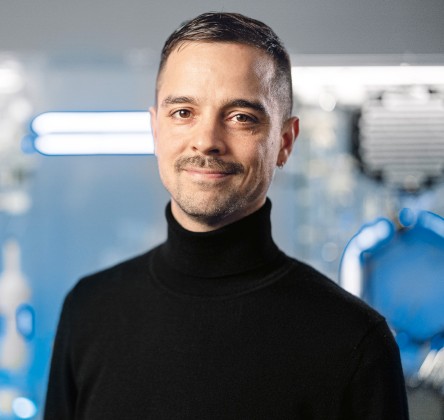
The core of the biological process is the bacterium Thermoanaerobacter kivui (T. kivui). The bacterium lives in Central Africa, deep in the mud of Lake Kivu, far away from light and oxygen. Nature has endowed it with a special enzyme that enables it to convert hydrogen (H2) and carbon dioxide (CO2) into formic acid (CH2O2) and vice versa.
This property was researched in-depth by the team led by Prof Dr Volker Müller, Head of the "Molecular Microbiology and Bioenergetics" department at Goethe University Frankfurt, with whom Festo is working closely on the project.
Efficient storage
Storing and transporting hydrogen remain a challenge to this day. Common methods compress hydrogen under high pressure, liquefy it at extremely low temperatures or convert it chemically. All these processes are energy-intensive and complicated.
Using the bacteria T. kivui, hydrogen can be converted into formic acid at temperatures of around 65 °C and a low pressure of 1.5 bar, which can be stored and transported with relatively little effort.
Although it is a biological process, this reaction takes place quickly because it is not linked to cell growth. Instead, the bacteria are used like catalysts: they are not used up and the process can be repeated as often as required with sufficient regeneration phases – just like in a cycle.

"The bacteria T. kivui stops growing at room temperature. Under these conditions, the cells can be stored for several years and reactivated at any time. This would enable it to be used whenever necessary."
Dr Adrian Eilingsfeld, Bionic Projects at Festo
Automating complex sequences
What was previously only possible in a laboratory can now be achieved on an industrial scale with the BionicHydrogenBattery. Many products from the Festo portfolio are used to automate the highly complex biotechnological processes.
A total of 117 different Festo product types (corresponding to 1,089 parts) are installed in the exhibit. For example, the new modular valve terminal VTUX in combination with the automation system CPX-E controls a large number of valves with a small footprint. The media valves VYKC from our Lifetech portfolio ensure the smooth transport of the viscous biomass solution into and out of the bioreactors. The flow through the filters is regulated by pinch valves VZQA. For precisely dispensing the minutest volumes of liquid into the reactors, the stepper motors EMMS-ST work in combination with pump heads as peristaltic pumps. A colour sensor SOEC detects even the smallest amounts of hydrogen in combination with supraparticles.
Reliable processes
Bacteria T. kivui are anaerobic, meaning they thrive exclusively in the absence of oxygen. The bacteria would die immediately if there was a leak in the system, and therefore pose no risk to people. At the same time, the absence of oxygen makes it impossible for the hydrogen to form an ignitable mixture. In addition, the system only contains very small quantities of it at any one time.
From hydrogen to formic acid and back again
Bacteria have optimised their metabolic processes over millions of years evolution. We can make the most of their capabilities by combining them with technology. The BionicHydrogenBattery is our replication of the biological process on a small scale; thanks to our automation technology we can now scale it up as required.
- 1: Propagate T. kivui bacteria under optimised conditions in a bioreactor.
- 2: Hydrogen is produced from water by electrolysis.
- 3: Bacteria convert CO2 and hydrogen into formic acid.
- 4: The acid is extracted and poured into a container.
- 5: Safely transporting the formic acid to where it is reconverted.
- 6: The same bacteria break down the formic acid back into its components hydrogen and CO2.
- 7: The hydrogen is converted back into electrical energy in a fuel cell.
Sustainable solutions for the future
Biologisation means that we no longer just learn from nature, but work together with it. That is how we enable ecological innovations and climate-friendly solutions for the world of tomorrow and contribute to improving the quality of life of current and future generations.
The energy-efficient and low-risk storage of hydrogen with the help of bacteria offers great potential. It allows us to produce and store hydrogen when enough sustainably generated energy is available – for example in summer or in windy and sunny countries – and to recover it when it is needed for generating power.

"By combining bacteria with technology, we can utilise their capabilities. This means that we no longer just learn from nature, but work together with it.
Sebastian Schrof, Bionic Projects at Festo